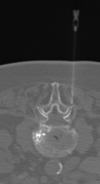Post-vertebral augmentation back pain: evaluation and management
- PMID: 22116104
- PMCID: PMC7964788
- DOI: 10.3174/ajnr.A2775
Post-vertebral augmentation back pain: evaluation and management
Abstract
Background and purpose: Vertebral augmentation is an established treatment for painful osteoporotic vertebral fractures of the spine. Nevertheless, patients may continue to have significant back pain afterward. The purpose of this study was to assess the source of persistent or recurrent back pain following vertebral augmentation.
Materials and methods: Our institutional review board approved this study. We evaluated 124 consecutive patients who underwent vertebral augmentation for painful osteoporotic vertebral fractures. All patients were evaluated after 3 weeks, 3 months, and 1 year following their procedure. Patients with any type of back pain after their procedure were examined under fluoroscopy.
Results: Thirty-four of 124 (27%) patients were men, and 90/124 (73%) were women. Persistent or recurrent back pain, not due to a new fracture or a failed procedure, was present in 29/124 (23%) patients. The source of pain was most often attributed to the sacroiliac and/or lumbar facet joints (25/29 or 86%). Seventeen of 29 (59%) patients experienced immediate relief after facet joint injection of a mixture of steroid and local anesthetic agents. The remaining 12 (41%) had relief after additional injections. Ten (34%) patients ultimately required radio-frequency neurolysis for long-term relief.
Conclusions: Back pain after vertebral augmentation may not be due to a failed procedure but rather to an old or a new pain generator, such as an irritated sacroiliac or lumbar facet joint. This is of importance not only for further pain management of these patients but also for designing trials to compare the efficacy of vertebral augmentation to other treatments.
Figures


Similar articles
-
Safety of vertebral augmentation with cranio-caudal expansion implants in vertebral compression fractures with posterior wall protrusion.Eur Radiol. 2020 Oct;30(10):5641-5649. doi: 10.1007/s00330-020-06889-4. Epub 2020 May 4. Eur Radiol. 2020. PMID: 32367420
-
A prospective, international, randomized, noninferiority study comparing an implantable titanium vertebral augmentation device versus balloon kyphoplasty in the reduction of vertebral compression fractures (SAKOS study).Spine J. 2019 Nov;19(11):1782-1795. doi: 10.1016/j.spinee.2019.07.009. Epub 2019 Jul 17. Spine J. 2019. PMID: 31325625 Clinical Trial.
-
Use and evaluation of a semi-permeable mesh implant in vertebral augmentation for the treatment of painful osteoporotic vertebral compression fractures.J Neurointerv Surg. 2016 Mar;8(3):328-32. doi: 10.1136/neurintsurg-2014-011512. Epub 2015 Jan 13. J Neurointerv Surg. 2016. PMID: 25586503
-
Vertebroplasty and kyphoplasty.Med Clin North Am. 2007 Mar;91(2):299-314. doi: 10.1016/j.mcna.2006.12.003. Med Clin North Am. 2007. PMID: 17321288 Review.
-
Vertebral augmentation in osteoporotic and osteolytic fractures.Curr Opin Support Palliat Care. 2009 Sep;3(3):219-25. doi: 10.1097/SPC.0b013e32832ea6e6. Curr Opin Support Palliat Care. 2009. PMID: 19553816 Review.
Cited by
-
Facet joint signal change on MRI at levels of acute/subacute lumbar compression fractures.AJNR Am J Neuroradiol. 2013 Jul;34(7):1468-73. doi: 10.3174/ajnr.A3449. Epub 2013 Feb 28. AJNR Am J Neuroradiol. 2013. PMID: 23449650 Free PMC article.
-
A nomogram for predicting residual low back pain after percutaneous kyphoplasty in osteoporotic vertebral compression fractures.Osteoporos Int. 2023 Apr;34(4):749-762. doi: 10.1007/s00198-023-06681-2. Epub 2023 Feb 4. Osteoporos Int. 2023. PMID: 36738335
-
Percutaneous vertebroplasty versus conservative treatment and placebo in osteoporotic vertebral fractures: meta-analysis and critical review of the literature.Eur Radiol. 2021 Nov;31(11):8542-8553. doi: 10.1007/s00330-021-08018-1. Epub 2021 May 7. Eur Radiol. 2021. PMID: 33963449 Review.
-
Use of Spinal Cord Stimulation in Elderly Patients with Multi-Factorial Chronic Lumbar and Non-Radicular Lower Extremity Pain.Cureus. 2017 Nov 17;9(11):e1855. doi: 10.7759/cureus.1855. Cureus. 2017. PMID: 29375941 Free PMC article.
-
Can facet joint block be a complementary or alternative therapeutic option for patients with osteoporotic vertebral fractures: a meta-analysis.J Orthop Surg Res. 2022 Jan 21;17(1):40. doi: 10.1186/s13018-022-02933-9. J Orthop Surg Res. 2022. PMID: 35063004 Free PMC article. Review.
References
-
- Riggs BL, Melton LJ, 3rd. Involutional osteoporosis. N Engl J Med 1986; 314: 1676– 86 - PubMed
-
- Borgstrom F, Zethraeus N, Johnell O, et al. . Costs and quality of life associated with osteoporosis-related fractures in Sweden. Osteoporos Int 2006; 17: 637– 50 - PubMed
-
- Silverman SL, Minshall ME, Shen W, et al. . The relationship of health-related quality of life to prevalent and incident vertebral fractures in postmenopausal women with osteoporosis: results from the Multiple Outcomes of Raloxifene Evaluation Study. Arthritis Rheum 2001; 44: 2611– 19 - PubMed
-
- Schlaich C, Minne HW, Bruckner T, et al. . Reduced pulmonary function in patients with spinal osteoporotic fractures. Osteoporos Int 1998; 8: 261– 67 - PubMed
-
- Lyles KW, Gold DT, Shipp KM, et al. . Association of osteoporotic vertebral compression fractures with impaired functional status. Am J Med 1993; 94: 595– 601 - PubMed
MeSH terms
LinkOut - more resources
Full Text Sources
Medical
